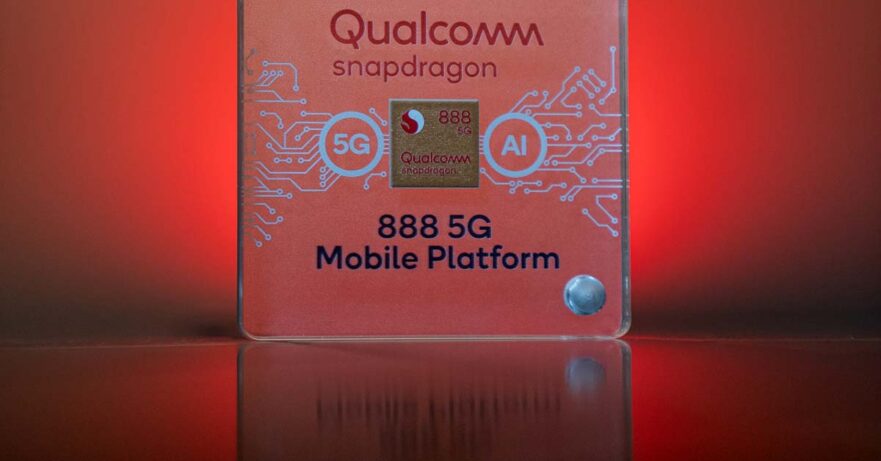Qualcomm’s next-flagship chipset is not called Snapdragon 765, as many expected; it’s Snapdragon 888, representing a number considered lucky in China.
(Update, December 19: This one’s interesting: iPhone 12 chip beats Snapdragon 888 in benchmarks.)
Why stray from the naming convention and go for 888? Qualcomm explained at the opening of the Snapdragon Summit that “the number 8 has represented our premium tier for over a decade — and this platform is the epitome of premium. It’s our most advanced platform ever, and it’s kicking off a new era for mobile.”
The company said the chip, made using a 5nm process, is equipped with the third-generation Snapdragon X60 5G Modem-RF System. It allows global compatibility by offering mmWave and sub-6 across all major bands worldwide. There’s also support for 5G carrier aggregation, standalone, non-standalone, Dynamic Spectrum Sharing, and global multi-SIM.
Qualcomm’s Snapdragon Summit: Day 1 keynote, in case you missed the livestream
Qualcomm’s Snapdragon 888 is also teased to arrive with its sixth-generation AI Engine running on a redesigned Qualcomm Hexagon processor, which can supposedly deliver 26 tera operations per second, the highest AI Engine TOPS in a mobile device thus far. Compare that with Snapdragon 865’s 15 TOPS.
For gamers, there’s the third-generation of Snapdragon Elite Gaming, which Qualcomm promises to deliver a “35% increase in GPU performance on top of the usual features it offers.”
For those interested in photography and videography, the chipmaker claims Snapdragon 888 will transform smartphones into professional quality cameras. “With our new gigapixel ISP, you can capture photos and videos at 2.7 gigapixels per second, or 120 photos at 12-megapixel resolution in 1 second,” it said. That’s up to 35% faster than the previous generation.
Coming to smartphones in 2021
The announcement of the Qualcomm Snapdragon 888 chipset gives us a sneak peek at what to expect from the next wave of Android flagship phones.
It will debut on the Xiaomi Mi 11, just as Snapdragon 855 debuted on the Xiaomi Mi 9, whose launch we at Revü witnessed at MWC [Mobile World Congress] 2019.
Are you excited for our latest flagship #Mi11 powered by the most powerful @Qualcomm chipset to date? Stay tuned! #InnovationForEveryone pic.twitter.com/MUFc251Dkw
— Xiaomi (@Xiaomi) December 1, 2020
Xiaomi announces that the Qualcomm Snapdragon 888 chip will debut on the Xiaomi Mi 11
Leaks show the Mi 11 Pro variant boasts a screen with a QHD+ resolution and up to 120Hz refresh rate and has support for many picture-quality enhancements. We also expect a 50-megapixel main camera and a 12-megapixel telephoto lens.
Word has it that the Xiaomi Mi 11 will be launched in January. Interesting that the Samsung Galaxy S21 is said to go official next month, too.
On another note, Xiaomi sub-brand Redmi‘s general manager, Lu Weibing, announced on Chinese social media platform Weibo that they’ll be part of the first to jump on the 888 train. Is he referring to the Redmi K40 line?
Realme has also confirmed that its phone code-named Race will be one of the first Snapdragon 888-powered flagship smartphones, too.
Think it is a pretty safe bet that @RealmeMobiles will be setting the bar for most affordable 5G flagship using @Qualcomm #Snapdragon 888 with this “Race” smartphone. Note: Its 2020 flagship Realme X50 shipped at $600 with the Snapdragon 865. pic.twitter.com/xdchGRLbQd
— Ben Wood (@benwood) December 1, 2020
‘Realme Race’: Affordable?
OPPO was likewise quick to issue a press release on the next Find X series, believed to be named the OPPO Find X3 lineup.
It will feature our Full-path Color Management System which will be the first Android 10-bit color management system.
— Henry Tang (@HenryTangHai) December 2, 2020
Looking forward to sharing more about our next flagship in the near future. #Snapdragon888
Could be launched as the OPPO Find X3 series
Other smartphone manufacturers confirmed to get Qualcomm’s new chip are ASUS, Black Shark, Lenovo, LG, Meizu, Motorola, Nubia, OnePlus, Sharp, Vivo, and ZTE.
Share this Post



